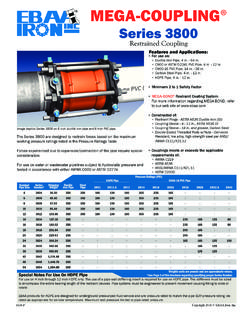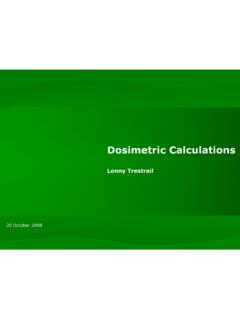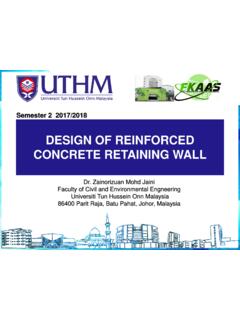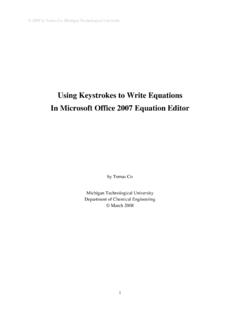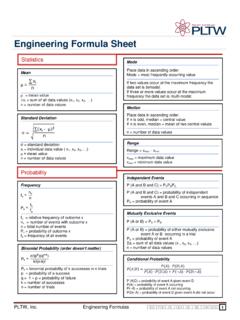Transcription of MEGALUG Series 1100 - EBAA
1 MEGALUG Series 1100 Mechanical Joint Restraint for Ductile Iron PipeFeatures and Applications: Sizes 3 inch through 54 inch Constructed of ASTM A536 Ductile Iron Torque Limiting Twist-Off Nuts MEGA-BOND Restraint Coating SystemFor more information on MEGA-BOND, refer to The Mechanical Joint Follower Gland is incorporated into the restraint Heavy Duty thick wall design Support Products Available:Split repair style available 3 inch through 48 Series 1100 SDSolid restraint harness available for push-on pipe Series 1700 Split restraint harness available for existing push-on Series 1100HD All MEGALUG and related restraint products can be furnished as packaged accessories complete with appropriate restraint, gasket, lubrication, and bolt-ing hardware For use on water or wastewater pipe-lines subject to hydrostatic pressure and tested in accordance with either AWWA C600 or ASTM D2774 Nominal Pipe SizeSeriesNumberShippingWeightsPostAssem blyDeflectionPressure Rating(PSI) 350411047.
2 73 200 NOTE: For applications or pressures other than those shown please contact EBAA for Patent , 4627774, 4779900, 4896903, 5544922 Made InThe USA0218-JCopyright 2018. EBAA Iron, Inc. All Rights OR EXTERNAL FORCEMax pressureMovementcauseswedges toincreasegripMax movementRated pressureWedge movementbeginsNormal operatingpressureRCM Since 1984, engineers and contractors designing and installing water and wastewater pipelines and systems have come to rely on the EBAA Series 1100 MEGALUG Mechanical Joint Restraint as the Product of Preference for effectively and economically restraining ductile iron pipe connections above or below ground.
3 MEGALUG Mechanical Joint Restraints replace external re-straints such as cumbersome concrete thrust blocks and corrod-ible metal tie rods creating a quicker, safer and more economical installation. Major testing laboratories agree as the 3 through 24 sizes are Underwriters Laboratories (UL) listed, and the 3 through 12 sizes are Factory Mutual (FM) approved. For use on all classes of ductile iron pipe (PC350 through PC150 and CL56 through CL50), for practically any application including valves, hydrants and pipe, the MEGALUG Mechanical Joint Restraint effectively and safely performs without damage to the pipe or cement linings.
4 The wedge style MEGALUG design reacts to the amount of force acting on the joint. When each wedge is set, the wedge teeth penetrate the pipe s outer surface, and the wedge does not move on the pipe. There is very little change in this interface until the wedge movement begins inside the pocket of the main casting. Once the wedge starts moving, the formation of the buttress begins. This dam of material (the wedge impression) is cold formed as the wedging action continues. If the force of pressure acting on the joint is released, the wedge moves back to near its original position. This engages the reserve-controlled move-ment or RCM.
5 The wedge is then ready for another round. After the wedge has moved to the back of the pocket at the maximum pressure or load, the wedge buttress are in shear. The maximum movement is about inch through the thirty-six inch size and inch for forty-two and forty-eight inch. The RCM is available even with severe cyclic loads. This has been tested to very high-pressure differentials and the wedge impressions look the same as if a single test had been performed. Typically, the depth of pipe wall pen-etration, or wedge impression at around 25,000 pounds of force per wedge (200 PSI on a six inch and 150 PSI on a twelve inch) is.
6 Finally, at roughly twice that force the penetration is around At these high pressures, there is no affect on the design thickness of ductile iron pipe made according to AWWA C150. The lack of damage to the cement lining clearly indicates that the thrust load is primarily longitudinal. This ability to move in the pocket allows for angular flexibility as well as longitudi-nal MEGALUG GRIPPING PERFORMANCE PROVENMEGALUG: THE PRODUCT OF PREFERENCE SINCE 1984 THE ORIGINAL PATENTEDGRIPPING WEDGESS ince 1964 EBAA Iron has responded aggressively to the needs of the water industry for better solutions to joint restraint problems - thus the development of the family of self actuating MEGALUG wedge action install using an ordinary wrench (box, ratchet, or air-driven), because the torque-limiting, twist-off nuts automatically shear during tightening when the proper torque is reached.
7 The same 1 wrench used to tighten the T-bolts on the 4 through 24 sizes can be used to tighten and shear the twist off nuts in all sizes. If removal becomes necessary, a 5/8 hex head remains so the screws can be loosened, and retightened with a torque-indicating wrench. During removal, the wedges are held in place by retainer MEGALUG gripping wedges provide resiliency to your pipeline design. In addition to deflecting as much as allowed by the mechanical joint during installation, it can also deflect after assembly:Sizes of 12 and below are capable of up to 3 degrees of deflection after installation (depending on the preset deflection.)
8 The 14 and 16 sizes are capable of 2 degrees 18 through 24 sizes are capable of degrees 30 through 48 sizes are capable of 1 degree 54 size has a degree PIPEThe 1100 Series MEGALUG can be used to restrain 3 - 8 SCH 40 or 80 steel pipe when joining to mechanical appurtenances. It can also be used on steel pipe in all sizes if the pipe s outside diameter is the same as the ductile iron pipe and its thickness is equal to or greater than PC350 ductile iron pipe in sizes of 16 inch and below and PC250 ductile iron pipe 18 inches and IRON PIPEGrey iron pipe diameters are often larger than ductile iron pipe diameters. The Series 1100 MEGALUG restraint may be used with grey iron pipe having standardized cast iron per AWWA C150 and C151, and with pit cast Classes A and B without modification.
9 Use of the Series 1100 with pit cast grey iron Classes C and D will require over sizing the MEGALUG . More information on this is explained in detail in Connections Bulletin DI-1 .MEGALUGT akes the LoadOn April 11, 1997 EBAA Iron performed a remark-able force demonstration of their Series 1100 MEGALUG Joint Restraint. With the use of EBAA s Series 1100 MEGALUG using a standard mechanical joint installation on 12 inch Ductile Iron Pipe, and a 80 Ton mo-tor crane, EBAA Iron lifted a D7 Caterpillar Track Type Tractor weighing in at 50,350 lbs. Along with this, the Series 1100 MEGALUG has been tested to over 700 PSI. Concluding that EBAA s MEGALUGS can take the Joint Restraint Sample Specifications(The text of the specifications below can be copied pasted from )Restraint devices for mechanical joint fittings and appurtenances conforming to either ANSI/AWWA C111 or ANSI/AWWA C153 , shall conform to the following:DesignRestraint devices for nominal pipe sizes 3 inch through 54 inch shall consist of multiple gripping wedges incorporated into a follower gland meeting the applicable requirements of ANSI/AWWA C110 devices shall have a working pressure rating of 350 psi for 3-16 inch, 250 psi for 18-48 inch and 200 psi for the 54 inch.
10 Ratings are for water pressure and must include a minimum safety factor of 2 to 1 in all body, wedges and wedge actuating components shall be cast from grade 65-45-12 ductile iron material in accordance with ASTM applications requiring restraint 30 inch and greater, an alternate grade of iron meeting the material requirements of ASTM A536 is acceptable, providing the device meets all end product performance iron gripping wedges shall be heat treated within a range of 370 to 470 (3) test bars shall be incrementally poured per production shift as per Underwriter s Laboratory ( ) Specifications and ASTM A536. Testing for tensile, yield and elongation shall be done in accordance with ASTM and nodularity tests shall be performed as recommended by the Ductile Iron Society, on a per ladle identification number consisting of year, day, plant and shift (YYDDD)(plant designation)(Shift number), shall be cast into each gland physical and chemical test results shall be recorded such that they can be accessed via the identification number on the casting.





